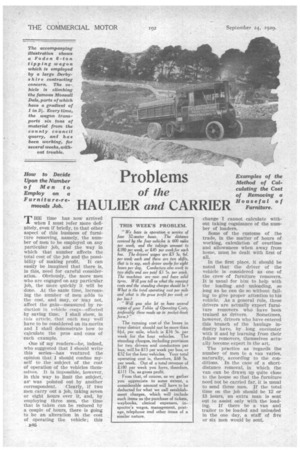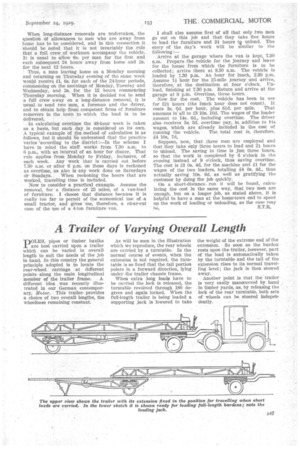Problems
Page 72

Page 73

If you've noticed an error in this article please click here to report it so we can fix it.
of the
HAULIER and CARRIER THE time has now arrived when I must refer more definitely, even if briefly, to that other aspect of this business of furniture removing, namely, the number of men to be employed on any particular job, and the way in which that number affects the total cost of the job and the possi bility of making profit. It can easily be imagined that there is, in this, need for careful consideration. Obviously, the more men who are engaged on any particular job, the more quickly it will be done. At the same time, in the number of men adds to the cost, and may, or may not, affect the gain—measured by reduction in vehicle costs—effected by saving time. I shall show, in tins article, that each may well have to be considered on its merits and I shall demonstrate how to calculate the pros and cons of each example.
One of my readers—he, indeed, who suggested that I should write this series—has ventured the opinion that I should confine myself to the subject of the cost of operation of the vehicles themselves. It is impossible, however, in this way to limit the subject, aswas pointed out by another
correspondent. Clearly, if two men carry out a job, taking seven or eight hours over it, anti, by employing three men, the time that is taken can be reduced by a couple of hours, there is going to be an alteration in the cost of operating the vehicle; this M6 change I cannot calculate without taking cognizance of the number of loaders.
Some of the customs of the trade, in the matter of hours of working, calculation of overtime and allowances when away from home, must be dealt with first of all.
• In the first place, it should be noted that the driver of the vehicle is considered as one of the crew of furniture removers. It is usual for him to help with the loading and unloading, so long as he can do so without failing to give proper attention to his vehicle. As a general rule, these drivers are actually expert furniture removers who have been trained as drivers. Sometimes, however, drivers who have entered this branch of the haulage industry have, by long encounter with it and by learning from their fellow removers, themselves actually become expert in the art.
The practice as regards the number of men to a van varies, naturally, according to the conditions. In the case of a shortdistance removal, in which the van can be drawn up quite close to the house so that the furniture need not be carried far, it is usual to send three men. If the total time on the job should be 12 or 13 hours, an extra man is sent out to assist only with the load
ing. If there be a van and trailer to be loaded and unloaded in the one day, a staff of five or six men would be sent. When long-distance removals are undertaken, the question of allowances to men who are away from home has to be considered, and in this connection it 'should be noted that it is not invariably the eule that a full crew of workmen accompany the vehicle. It is usual Ito allow 6s: per man for the first and each subsequent 24 hours away from home and 2s. for the next 12 hours.
Thus, a man leaving home on a Monday morning and returning on Thursday evening of the same week would receive £1, 6s. for each of the 24-hour periods, commencing on the mornings of Monday, Tuesday and Wednesday, and 2s, for the 12 hours commencing Thursday morning. When it is decided not to send a full crew away on a long-distance removal, it is usual to send two men, a foreman and the driver, and to obtain help from competent firms of furniture removers in the town to which the load is to be delivered,:
In calculating overtime the 48-hour week is taken as a basis, but each day is considered on RS own. A typical example of the method of calculation is as follows, but it should he understood that the practice varies 'according to the district :—In the scheme I have in mind the staff works from 720 a.m. to 6 p.m., with an interval of an hour for dinner. That rule applies from Monday to Friday, inclusive, of each week. Any work that is carried out before 7.30 a.m. or after 6 p.m. on those days is reckoned as overtime, as also is any work done on Saturdays ot Sundays. When reckoning the hours that are worked, travelling time is included.
Now to consider a practical example. Assume the removal, for a distance of 25 miles, of a van-load of furniture. I choose that distance because it is really too far to permit of the economical use of. a small tractor, and gives me, therefore, a clear-cut case of the use of a 4-ton furniture van.
I shall also assume first of all that only two men go out on this job and that they take five hours to load the furniture and 3i hours to unload. The story of the day's work will be similar to the following:—
Arrive at the garage where the van is kept, 720 a.m. Prepare the vehicle for the journey and leave for the house from Which the furniture is to be collected ; arrive there at 8.30 a.m. The vehicle is loaded by 1.30 p.m. An hour for lunch, 2.30 p.m. 'Assume 1+. hour for the 25-mile journey and arrive, therefore, at the destination at four o'clock. Unload; finishing at 7.30 p.m. Return and arrive at the garage at 9 p.m. Overtime, three hours.
Now for the cost. The vehicle has been in use for 12i hours (the lunch hour does not count). It.
costs 3s. Cd. per hour, plus 61d. per mile. That amounts in all to 13 10s. 10d. The wages of the loader amount to 14s. 6d., including overtime. The driver also receives 5s. 30. overtime pay, in addition to his wages, which are already included in the cost of running the vehicle. The total cost is, therefore, £4 10s, 7d.
Suppose, now, that three men are employed and that they take only three hours to load and 2i hours to unload. The saving in time is just three hours, so that the work is completed by 6 o'clock in the evening instead of 9 o'clock, thus saving overtime. The cost is £3 Os. 4d. for the machine and £1 for the wages of the two loaders, totalling £4 Os. 4d., thus actually. saving 10s. 6d. as well as gratifying the customer by doing the job quickly.
On a short-distance. run it will be found, calculating the cost in the same way, that two men are enough, but on a longer job, as stated above, it is helpful to have a man at the home-town end to speed up the work of loading or unloading, as the case may be, S.T.R.




















































































































